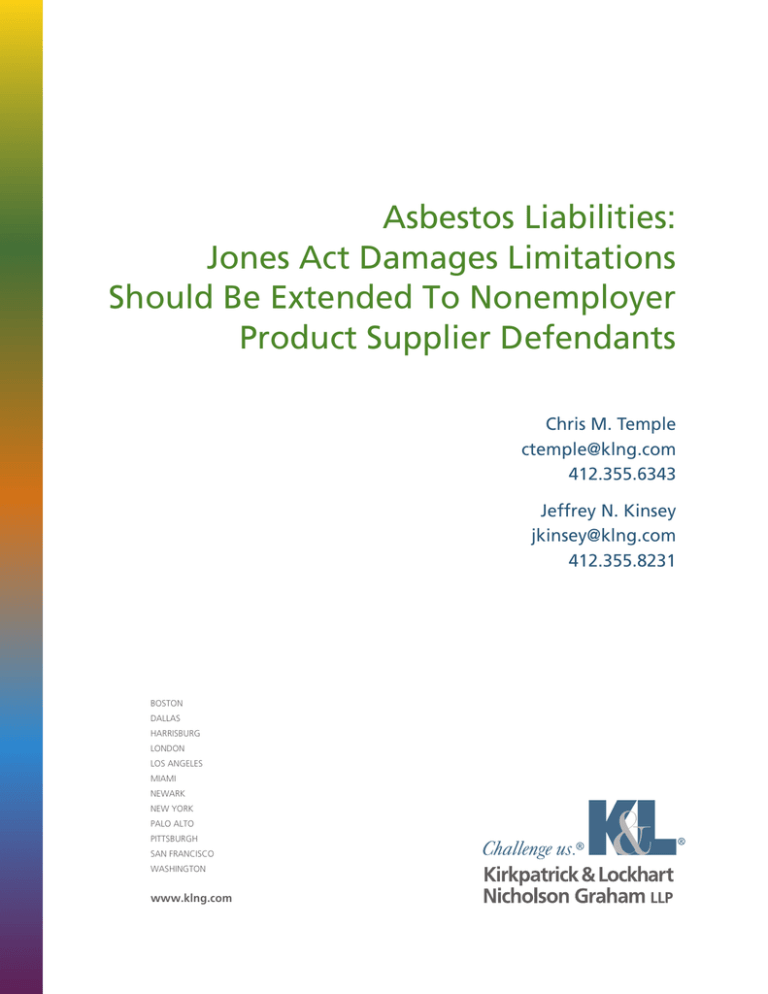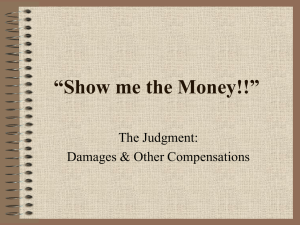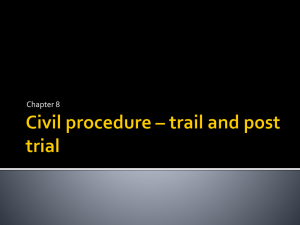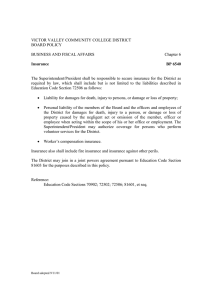
Asbestos Liabilities:
Jones Act Damages Limitations
Should Be Extended To Nonemployer
Product Supplier Defendants
Chris M. Temple
ctemple@klng.com
412.355.6343
Jeffrey N. Kinsey
jkinsey@klng.com
412.355.8231
by
t
BOSTON
DALLAS
HARRISBURG
LONDON
LOS ANGELES
MIAMI
NEWARK
NEW YORK
PALO ALTO
PITTSBURGH
SAN FRANCISCO
WASHINGTON
www.klng.com
Kirkpatrick & Lockhart Nicholson Graham LLP (K&LNG) has approximately 1,000 lawyers and represents entrepreneurs, growth and
middle market, capital markets participants, companies and leading FORTUNE 100 and FTSE 100 global corporations nationally and
internationally.
K&LNG is a combination of two limited liability partnerships, each named Kirkpatrick & Lockhart Nicholson Graham LLP, one qualified in
Delaware, U.S.A. and practicing from offices in Boston, Dallas, Harrisburg, Los Angeles, Miami, Newark, New York, Palo Alto, Pittsburgh,
San Francisco and Washington, and one incorporated in England, practicing from the London office.
This publication/newsletter is for informational purposes and does not contain or convey legal advice. The information herein should not
be used or relied upon in regard to any particular facts or circumstances without first consulting a lawyer.
Data Protection Act 1988 - We may contact you from time to time with information on Kirkpatrick & Lockhart Nicholson Graham LLP
seminars and with our regular newsletters, which may be of interest to you. We will not provide your details to any third parties. Please
e-mail cgregory@klng.com if you would prefer not to receive this information.
© 2006 KIRKPATRICK & LOCKHART NICHOLSON GRAHAM LLP. ALL RIGHTS RESERVED.
Asbestos Liabilities: Jones Act Damages
Limitations Should Be Extended to
Nonemployer Product Supplier Defendants
By CHRIS M. TEMPLE and JEFFREY N. KINSEY1
Summary
While the Jones Act has traditionally limited injured merchant seamen to recovering only pecuniary
damages from their employers, there is a question whether the same limitation should also be extended
to potential recoveries against nonemployer defendants, such as manufacturers of marine equipment.
This paper examines a Jones Act seaman’s ability to collect nonpecuniary damages, such as punitive
damages and loss of consortium damages, against nonemployer defendants in light of the Fifth Circuit’s
opinion in Scarborough v. Clemco Indus..2 Product manufacturers may find the Scarborough decision
particularly useful in defending against punitive damages claims brought by Jones Act seamen.
SECTION I:
An Overview of Damages Recoverable
by a Jone s Act Seaman
The Jones Act3 permits a seaman4 to recover for injuries resulting from his or her employer’s negligence.
The Jones Act allows a seaman to avoid state workers’ compensation systems and to recover from
employers some types of damages that are customarily compensable in state court tort cases. Among
the types of damages that a Jones Act seaman can recover from his or her employer are lost earnings,
impairment of earning capacity, past and future medical expenses, and pain and suffering.
While the Jones Act allows tort-like causes of action against employers, the United States Supreme
Court has specifically narrowed the types of damages that are recoverable. In Miles v. Apex Marine
Corp., the U.S. Supreme Court held that a Jones Act seaman cannot recover “nonpecuniary” damages
against his employer, regardless of whether the claim is brought under the Jones Act, the Death on
the High Seas Act (“DHSA”),5 or through an unseaworthiness claim under general maritime law.6 By
limiting the damages that a Jones Act seaman can obtain against an employer, the Supreme Court was
applying “a uniform rule applicable to all actions.”7
1
Chris Michael Temple is a partner and Jeffrey N. Kinsey is an associate in the Pittsburgh office of the law firm of Kirkpatrick & Lockhart Nicholson Graham
LLP (“K&LNG”).
2
Scarborough v. Clemco Indus., 391 F.3d 660 (5th Cir. 2004), cert. denied, 125 S. Ct. 1932 (Apr. 25, 2005).
3
The Jones Act is codified at 46 U.S.C. App. § 688 (2000). Although the text of the Jones Act itself is not lengthy, it generally extends the same rights and
privileges to seamen that were extended to employees of interstate railway carriers by the Federal Employer’s Liability Act.
4
While the Jones Act provides that a seaman can bring a negligence claim against his or her employer, Congress has not defined the term “seaman.” Whether
an employee will qualify as a seaman will depend upon the facts of each case. Generally, an employee will be considered a seaman if his or her duties
contribute to the function of the vessel or the accomplishment of its mission and the employee has a connection to a vessel in navigation that is substantial in
terms of both its duration and nature. See Chandris, Inc. v. Latsis, 515 U.S. 347, 376 (1995).
5
46 U.S.C. App. § 761 et seq. (2000).
6
Miles v. Apex Marine Corp., 498 U.S. 19, 32 (1990).
7
Id.
1
Unfortunately, the Supreme Court did not define the term “nonpecuniary damages.” In Miles, the
plaintiff attempted to recover loss of society damages against her deceased husband’s former employer.8
From the Miles case, we know that loss of society damages and punitive damages are not recoverable
in Jones Act claims. The Supreme Court did not elaborate on what other types of damages may be
considered nonpecuniary damages.
SECTION II:
The Validity of Nonpecuniary Damage Claims Against
Nonemployer Defendants After Scarborough
An issue left open by the Miles opinion is whether a Jones Act seaman can recover nonpecuniary
damages against nonemployer defendants. In addition to suing their employers, Jones Act seamen
frequently sue manufacturers whose products allegedly caused a seaman’s injury. Manufacturers and
distributors of marine equipment used on vessels assert that the Miles uniformity principle limits a Jones
Act seaman’s recovery to pecuniary damages for any claim that he or she brings, regardless of whether
the claim is brought against the seaman’s employer or against a product manufacturer. Not surprisingly,
plaintiffs have argued that the Miles decision only bars a plaintiff from recovering nonpecuniary
damages against his or her actual employer, thereby allowing the plaintiff to seek all other available
damages, including punitive and loss of consortium damages, against nonemployer defendants.
Since the Miles decision was published in 1990, federal district courts across the country have struggled
with the Supreme Court’s discussion of the need for uniformity of damages under various maritime law
claims. Some district courts have allowed Jones Act seamen to recover nonpecuniary damages against
any nonemployer defendant.9 District courts that have permitted these claims typically find that there is
no need for uniform treatment of an employer and other defendants because Congress solely dealt with
liability issues between Jones Act seamen and their employers.10 Those courts opine that because there
is no statutory scheme creating a specific cause of action for seamen against nonemployer defendants,
maritime law can be supplemented by traditional state tort law, which typically allows a plaintiff to
collect, among other things, punitive damages and loss of consortium damages.11
The Fifth Circuit, undoubtedly an influential circuit in shaping maritime law because of the numerous
cases filed in connection with shipyards and ports lining the coasts of its territory, addressed this
precise issue—whether a Jones Act seaman can recover nonpecuniary damages against a nonemployer
manufacturer—in Scarborough v. Clemco Indus..12 When Scarborough reached the Fifth Circuit
on appeal, district courts within the circuit were split on the issue of whether the Miles uniformity
principle serves to limit the recovery of a seaman to pecuniary damages in cases against nonemployer
defendants.13 In Scarborough, the surviving spouse of a Jones Act seaman filed a wrongful death
2
8
Id. at 21-22. Courts frequently use the terms “loss of society” and “loss of consortium” interchangeably, depending on the law of each state. “Loss of consortium” is used in this paper to refer to these claims.
9
See e.g., In re Consolidated Coal Co., 228 F. Supp. 2d 764 (N.D. W.Va. 2001); In re Petition of Cleveland Tankers, Inc., 843 F. Supp. 1157 (E.D. Mich. 1994);
Sugden v. Puget Sound Tug & Barge Co., 796 F. Supp. 455 (W.D. Wash. 1992).
10
See e.g., In re Consolidated Coal Co., 228 F. Supp. 2d at 771-72.
11
Id.
12
Scarborough v. Clemco Indus., 391 F.3d 660 (5th Cir. 2004).
13
See e.g., Stogner v. Cent. Boat Rentals, Inc., 326 F. Supp. 2d 754, 759 (E.D. La. 2004) (holding that Miles does not forbid the recovery of nonpecuniary
damages in suits by Jones Act seamen against nonemployer defendants); In re Denet Towing Serv., Inc., No. Civ. A. 98-1523, 1999 WL 329698, at *2 (E.D.
La. May 21, 1999) (holding that Miles does not preclude recovery of nonpecuniary damages in suits by Jones Act seamen against nonemployer defendants);
but see, e.g., Trident Marine, Inc. v. M/V Atticos, 876 F. Supp. 832, 837 (E.D. La. 1994) (holding that loss of society damages are not available to the survivors
of a Jones Act seaman in suits against nonemployer defendants).
action against her deceased husband’s former employer and various manufacturers and distributors of
sandblasting safety equipment.14 The plaintiff alleged that her husband died of silicosis as a result of the
defendants’ negligence.15
The Fifth Circuit concluded that a plaintiff who has invoked Jones Act seaman status cannot recover
nonpecuniary damages from a nonemployer defendant.16 In effect, any plaintiff who sues his
employer for negligence under a Jones Act claim will be barred from seeking punitive damages or loss
of consortium damages against any other defendant which allegedly manufactured or sold products
used by the employer or the plaintiff during employment. In determining the effect of the Supreme
Court’s call for uniformity in maritime law claims, the Scarborough court stated: “The Miles opinion is
concerned with uniformity in the damages recoverable by a Jones Act seaman and his survivors, not with
uniformity of the types of damages to which various defendants are subjected.”17
In cases where the plaintiff does not want to be characterized as a Jones Act seaman because he or
she is seeking substantial punitive damages from a product manufacturer, defendants may force the
plaintiff into Jones Act seaman status.18 A district court in the Fifth Circuit recently allowed a product
manufacturer to prove that a plaintiff was a Jones Act seaman even though the plaintiff did not want to
be characterized as such.19 The party who is seeking to obtain the benefits of Jones Act seaman status
has the burden of proving that the plaintiff meets the definition of a seaman.20 Product manufacturers in
these cases should consider whether it is beneficial to prove that the plaintiff is a Jones Act seaman. In
the Fifth Circuit at least, once a plaintiff is considered a Jones Act seaman, he or she is precluded from
recovering punitive damages and loss of consortium damages against product manufacturers for any type
of claim—whether it be for breach of warranty, negligence or strict liability.21
Conclusion
While the Scarborough decision prevents Jones Act seamen from collecting punitive damages and
loss of consortium damages against nonemployer defendants in the Fifth Circuit, this decision could
prove to have national significance. As previously discussed, lower courts faced with the issue of
whether nonpecuniary damages can be recovered from nonemployer defendants have reached differing
opinions. However, the Fifth Circuit’s ruling is a strong decision that marine product manufacturers and
distributors should consider in defense of maritime and shipyard claims.
14
Scarborough, 391 F.3d at 660.
15
Id.
16
Id. at 668.
17
Id.
18
See Mudrick v. Cross Serv., Inc., No. Civ.A. G-04-593, 2005 WL 3359355 (S.D. Tex. Dec. 9, 2005).
19
Id. at *2.
20
Id.
21
See generally, id.
3
State Street Financial Center
One Lincoln Street
Boston, Massachusetts 02111
617.261.3100
2828 North Harwood Street
Suite 1800
Dallas, Texas 75201
214.939.4900
17 North Second Street
18th Floor
Harrisburg, Pennsylvania 17101
717.231.4500
110 Cannon Street
London EC4N 6AR
+44 (0) 20 7648 9000
10100 Santa Monica Boulevard
Seventh Floor
Los Angeles, California 90067
310.552.5000
201 South Biscayne Boulevard
20th Floor
Miami, Florida 33131
305.539.3300
One Newark Center, Tenth Floor
Newark, New Jersey 07102
973.848.4000
599 Lexington Avenue
New York, New York 10022
212.536.3900
Henry W. Oliver Building
535 Smithfield Street
Pittsburgh, Pennsylvania 15222
412.355.6500
630 Hansen Way
Palo Alto, CA 94304
650.798.6700
Four Embarcadero Center, 10th Floor
San Francisco, California 94111
415.249.1000
1601 K Street N.W.
Washington, DC 20006
202.778.9000
www.klng.com






